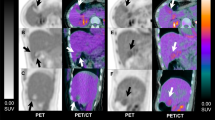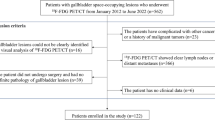Abstract
Aim
Thick-walled gallbladder is difficult to characterize on conventional imaging. 18F-FDG PET was used to differentiate benign and malignant wall thickness and compared with histopathology.
Methods
Thirty patients with gallbladder (GB) wall thickening (focal > 4 mm and diffuse > 7 mm), underwents uspected on ultrasound, or CT scan, and underwent 18F-FDG PET. Histopathology of the specimen was compared with imaging findings.
Results
The mean age was 48.22 ± 31.33 years with a M:F 1:4 ratio. Twenty patients had diffuse and 10 had focal thickening. On 18F-FDG PET, lesion was benign in 12, malignant in 13, and indeterminate in 5. Histopathology was malignancy in 12; benign in 18-chronic cholecystitis in 11, xanthogranulomatous in 4, IgG4 related in 2, and polyp in 1. The mean GB wall thickness was 7.79 ± 3.59 mm (10.34 malignant and 6.10 in benign, p = 0.001). At a cutoff of 8.5 mm, the sensitivity and specificity of detecting malignancy was 94% and 67%. The mean SUV uptake was 7.46 (benign 4.51, malignant 14.26, p = 0.0102). At a cutoff of 5.95, the sensitivity and specificity of detecting malignancy was 92% and 79%. For 18F-FDG PET, overall sensitivity was 91%, specificity 79%, PPV 77%, NPV 92%, and diagnostic accuracy was 84%.
Conclusion
18F-FDG PET is a reliable method of differentiation between benign and malignant thickening of the gallbladder particularly when wall thickness and SUV value is taken into account.


Similar content being viewed by others
References
Malhotra RK, Manoharan N, Shukla NK, Rath GK. Gallbladder cancer incidence in Delhi urban: a 25-year trend analysis. Ind J Cancer. 2017;54:673–7.
Köhn N, Maubach J, Warschkow R, Tsai C, Nussbaum DP, Candinas D, et al. High rate of positive lymph nodes in T1a gallbladder cancer does not translate to decreased survival: a population-based, propensity score adjusted analysis. HPB (Oxford). 2018 Jun 8 S1365-182X(18)30819-0. https://doi.org/10.1016/j.hpb.2018.05.007.
Goussous N, Maqsood H, Patel K, Ferdosi H, Muhammad N, Sill AM, et al. Clues to predict incidental gallbladder cancer. Hepatobiliary Pancreat Dis Int. 2018;17:149–57.
Mitchell CH, Johnson PT, Fishman EK, Hruban RH, Raman SP. Features suggestive of gallbladder malignancy: analysis of T1, T2, and T3 tumors on cross-sectional imaging. J Comput Assist Tomogr. 2014;38:235–41.
Wasnik AP, Davenport MS, Kaza RK, Weadock WJ, Udager A, Keshavarzi N, et al. Diagnostic accuracy of MDCT in differentiating gallbladder cancer from acute and xanthogranulomatous cholecystitis. Clin Imag. 2018;50:223–8.
Chen LD, Huang Y, Xie XH, Chen W, Shan QY, Xu M, et al. Diagnostic nomogram for gallbladder wall thickening mimicking malignancy: using contrast-enhanced ultrasonography or multidetector computed tomography? Abdom Radiol. 2017;42:2436–46. https://doi.org/10.1007/s00261-017-1162-z.
Kishore R, Nundy S, Mehrotra S, Mehta N, Mangla V, Lalwani S. Strategies for differentiating gallbladder carcinoma from xanthogranuomatous cholecystitis – a tertiary care centre experience. Ind J Surg Oncol. 2017;8:554–9.
Rao RV, Kumar A, Sikora SS, Saxena R, Kapoor VK. Xanthogranulomatous cholecystitis: differentiation from associated gall bladder carcinoma. Trop Gastroenterol. 2005;26:31–3.
Kim SJ, Lee JM, Lee JY, Kim SH, Han JK, Choi BI, et al. Analysis of enhancement pattern of flat gallbladder wall thickening on MDCT to differentiate gallbladder cancer from cholecystitis. Am J Roentgenol. 2008;191:765–71.
Sureka B, Singh VP, Rajesh SR, Laroia S, Bansa K, Rastogi A, et al. Computed tomography (CT) and magnetic resonance (MR) findings in xanthogranulomatous cholecystitis: retrospective analysis of pathologically proven 30 cases – tertiary care experience. Pol J Radiol. 2017;82:327–32.
Sacks A, Peller PJ, Surasi DS, Chatburn L, Mercier G, Subramaniam RM. Value of PET/CT in the management of primary hepatobiliary tumors, part 2. AJR Am J Roentgenol. 2011;197:260–5.
Covera CU, Blumgart LH, Akhurst T, DeMatteo RP, D’Angelica M, Fong Y, et al. 18 F-fluorodeoxyglucose positron emission tomography influences management decisions in patients with biliary cancer. J Am Coll Surg. 2007;206:57–65.
Annunziata S, Pizzuto AP, Caldarella C, Galiandro F, sadeghi R, Treglia G. Diagnostic accuracy of fluorine-18-fluorodeoxyglucose positron emission tomography in gallbladder cancer: a meta-analysis. World J Gastroenterol. 2015;21:11481–8.
Oe A, Kawabe J, Toril K, Higashiyama S, Kotani J, Hayashi T, et al. Distinguishing between benign from malignant gallbladder wall thickening using FDG-PET. Ann Nucl Med. 2006;20:699–703.
Roms-Font C, Gomez-Rio M, Rodriguez-Fernandez A, Jimenez-Haffernan A, Sanchez RS, Llamas-Elvira JM. Ability of FDG-PET/CT in the detection of gallbladder cancer. J Surg Oncol. 2014;109:218–24.
Anderson CD, Rice MH, Pinson W, Chapman WC, Chari RS, Delbeke D. Fluorodeoxyglucose pet imaging in the evaluation of gallbladder carcinoma and cholangiocarcinoma. J Gastrointest Surg. 2004;8:90–7.
Nishiyama Y, Yamamoto Y, Fukunaga K, Kimura N, Miki A, Sasakawa Y, et al. Dual-time –point 18F-FDG PET for evaluation of gallbladder carcinoma. J Nucl Med. 2006;47:633–8.
Jindal G, Singal S, Nagi B, Mittal A, Mittal S, Singal R. Role of multidetector computed tomography (MDCT) in evaluation of gallbladder malignancy and its pathological correlation in an indian rural center. Maedica – J Clin Med. 2018;13:55–60.
Hwang JP, Lim I, Cho EH, Kim BI, Choi CW, Lim SM. Prognostic value of SUV max measured by Fluorine-18 fluorodeoxyglucose positron emission tomography with computed tomography in patients with gallbladder cancer. Nucl Med Mol Imag. 2014;48:114–20.
Koh T, Taniguchi H, Yamaguchi A, Kunishima S, Yamagishi H. Differential diagnosis of gallbladder cancer using positron emission tomography with fluorine-18-labeled fluoro-deoxyglucose (FDG-PET). J Surg Oncol. 2003;84:74–81.
Furukawa H, Ikuma H, Assakura K, Uesaka K. Prognostic importance of standardized uptake value on F-18 fluorodeoxyglucose-positron emission tomography in biliary tract carcinoma. J Surg Oncol. 2009;100:494–9.
Rodriguez-Fernandez A, Gomez-Rio M, Llamas-Elvira JM, Ortega-Lozano S, Ferron-Orihuela JA, Ramia-Angel JM, et al. Positron-emission tomography with fluorine-18-fluoro-2-deoxy-Dglucose for gallbladder cancer diagnosis. Am J Surg. 2004;188:171–5.
Kapoor VK, Singh R, Behari A, Sharma S, Kumar A, Prakash A, et al. Anticipatory extended cholecystectomy: the ‘Lucknow’ approach for thick walled gall bladder with low suspicion of cancer. Chin Clin Oncol. 2016;5:8. https://doi.org/10.3978/j.issn.2304-3865.2016.02.07.
Author information
Authors and Affiliations
Contributions
VG, TDY: concept and idea; KSV: clinical data collection; NK: Radiological data, BRM: PET-CT data; KV: Pathological data, VG, YRS, SI: drafting and correction.
Corresponding author
Ethics declarations
Ethical Clearance
Obtained.
Rights and permissions
About this article
Cite this article
Gupta, V., Vishnu, K.S., Yadav, T.D. et al. Radio-pathological Correlation of 18F-FDG PET in Characterizing Gallbladder Wall Thickening. J Gastrointest Canc 50, 901–906 (2019). https://doi.org/10.1007/s12029-018-0176-2
Published:
Issue Date:
DOI: https://doi.org/10.1007/s12029-018-0176-2




